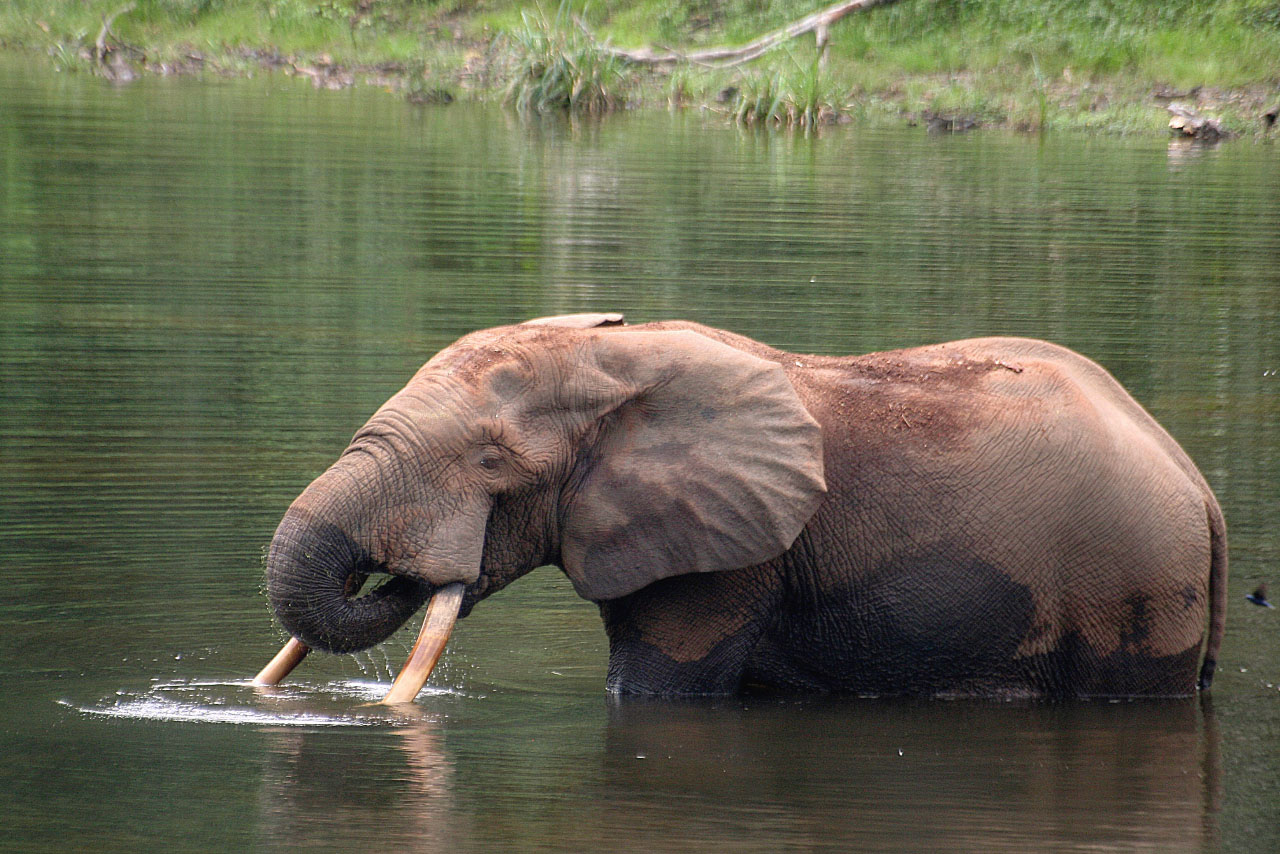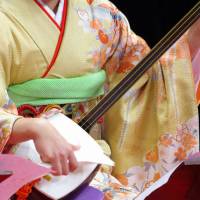Next time you attend a shamisen performance, neither you nor most anyone else there will likely notice the elephant in the room. And those who do probably won't have given it much thought.
We're not talking about a flesh-and-blood, 2-ton elephant, of course, but the bachi (large plectrum) used to play the traditional Japanese three-stringed instrument.
The best bachi are made from hard tusk ivory, and "Japan is the only country where a strong demand for 'hard,' or forest, elephant ivory still exists," Dr. Tomoaki Nishihara wrote in an article in the July-December 2012 issue of the elephant-research journal Pachyderm.
"Historically, Japanese ivory carvers have produced most of their items from 'hard ivory' from Asian elephants and from forest elephants of Central Africa, which is preferred to 'soft ivory' from the savannah elephants of eastern, western and southern Africa.
"The major ivory items made in Japan are hanko (personal name seals) and musical implements such as bachi, preferably made of hard ivory," Nishihara explained there.
However, a global ban on ivory sales took effect in 1989 under the Convention on Illegal Trade in Endangered Species of Wild Fauna and Flora (CITES), and as Japan could no longer legally import it, stocks soon started to run low. Then, in 1999 and 2008, CITES allowed one-off sales of ivory from African nations. These allowed Japanese dealers to stock up — but only with soft ivory from savannah elephants, as that was the only type permitted in the sales.
Consequently, ivory items in Japan have of late been crafted primarily from soft ivory, which most of its artisans consider useless for traditional items — particularly bachi.
"Although Japanese demand for hanko made of ivory has been declining in the last decade, it is clear there is still continuous demand for ivory, especially for hard ivory from the Central African region for bachi," said Brazzaville, Republic of Congo-based Nishihara, a senior technical adviser on operations and protection for the Wildlife Conservation Society, which currently manages some 200 million acres of wild places around the world.
"A bachi made of hard ivory provides better and softer sound; bachi made of soft ivory do not produce good sound, according to Japanese shamisen players," he notes.
Bachi can be made from wood, synthetic resin and tusk fragments, but professional shamisen players generally insist on a full-size plectrum of hard ivory. And though hanko can be crafted from small pieces of ivory and other materials, such as water buffalo horn or titanium, bachi are about 25 cm long, 15 cm wide and up to 2.5 cm thick. So, as elephant tusks are, like teeth, partially hollow, the tip of a large, uncracked tusk weighing at least 15 kg is required to make a full-sized bachi.
Japanese dealers still have ivory stocks from before the CITES trade ban, and from the sales in 1999 and 2008, but the average weight of remaining tusks is about 12 kg, and none of the ivory in those sales was meant to have been be hard ivory from forest elephants.
This, according to Nishihara, is why there is illegal demand in Japan for large, hard-ivory tusks from African forest elephants. And although he has not found clear evidence of hard ivory being smuggled into this country, he suspects there must be illegal trading along the supply chain.
Mindful that Japan has about 1,000 professional shamisen players who buy new bachi when theirs become worn, Nishihara observes: "A stable demand for bachi exists from professional shamisen musicians because they change them regularly.
"Musicians vary widely as to how often they change ivory bachi — some once per year, others only every 10 years. Musicians use wooden bachi for practicing and ivory ones only for public performances, though that too varies among musicians. However, 1 mm of wear from a bachi significantly reduces sound quality and musicians need to replace it," he reports.
And each hard-ivory bachi that is replaced represents a demand for a forest-elephant tusk.
As chance would have it, when I was writing this column on April 19, CNN's website carried a story headed, "Rangers risk their lives to save African forest elephants." In that article its author, Aja Harris, talked with Zacharie Nzooh of the World Wildlife Fund, who leads a team of conservationists working to deter poachers in the Lobeke National Park in southeast Cameroon — part of the Congo Basin forests where Nishihara conducts his research.
"The major threat is elephant poaching for ivory," Nzooh told Harris. "There was a big elephant population when I first arrived here in 2002; I'd see 35 elephants at once." Today Nzooh and his colleagues are lucky to see groups of three or four.
"Over the past decade, conservationists say poachers have shrunk Africa's forest elephant population by 62 percent, threatening the magnificent mammals with eventual extinction," Harris wrote.
"Poachers are getting hungrier for ivory; the precious commodity is selling for hundreds, even thousands of dollars per kilogram on the black market. The lucrative poaching market has been built on high demand from Asia, attracting organized criminals who are increasingly using more sophisticated methods in their illegal activities," he pointed out.
Still, Nzooh is not resigned to extinction of the forest elephants. "If significant efforts are put in place the elephants will survive," he declared. "Those efforts must be made on different levels, on site level, on an international level and on a national level."
But with ivory worth so much in a region where most have so little, perhaps only heroic efforts will make a difference. For now, Africa's forest elephants continue to be slaughtered and their ivory trafficked.
According to Tom Milliken, writing in the same issue of Pachyderm as Nishihara, "Illegal trade in ivory has surged in each successive year, reaching the highest level in at least 16 years in 2011. The weight of ivory involved in the illegal ivory trade is now roughly three times greater than what was occurring in 1998. ... It is increasingly evident that elephants are facing the most serious conservation crisis since the 1989 trade ban was imposed under (CITES)."
Like Nishihara, Milliken — elephant and rhino programme coordinator for TRAFFIC, an international NGO that monitors the legal and illegal trade in wildlife — sees a highly professional black market driving the wholesale slaughter of elephants.
"The sharp upward trend is being driven by a major rise in large-scale movements of ivory," he stated. "The largest of these are ivory seizures that involve 800 kg or more in a single consignment; there were eight such seizures in 2009, nine in 2010 and 17 in 2011, totaling nearly 61 tons. The increasing pattern of large movements of ivory is the telltale work of sophisticated international criminal syndicates that link Africa with Asia."
Inevitably, even as many large illegal shipments are being intercepted, others are getting through and feeding growing demand in Asia.
"It is disappointing to note that few if any arrests occur with respect to most large-scale ivory-seizure cases. Failing to prosecute and convict the criminals behind serious ivory-trade crime is a key reason that it continues," insists Milliken. "For this reason, investigation of large-scale ivory seizures should be recognized by the CITES parties as the single most important ivory-trade infraction for focused follow-up attention."
He identifies Kenya, Tanzania and South Africa as the main exit points for ivory from Africa. From there, it generally travels to countries such as Hong Kong, Malaysia, the Philippines and Vietnam before shipment to user nations, primarily China and Thailand.
"These nine countries and territories, in varying combinations, comprise the paramount trade chain through which the greatest volume of ivory is flowing," explains Milliken, who maintains that China's illicit ivory trade has been growing steadily since 1996. In 2011, he says, it accounted for about 40 percent of all illegal ivory-trade transactions — while over the same period Japan's involvement decreased steadily, to less than 1 percent of all illegal transactions in 2011.
Nevertheless, with the number of elephants being killed each year in Africa ranging between 17,000 and 25,000, Japan is still likely to be the final destination of hundreds of tusks, including hard ivory torn from the carcasses of forest elephants.
Nishihara believes information and education can shut down Japan's illegal trade altogether, but vendors remain sadly ignorant. His research found that while Japan's professional ivory-carvers can distinguish between hard and soft ivory, more than 70 percent of retail shopkeepers selling ivory items cannot. Also, two-thirds of those visited didn't know the origin of their elephant ivory, and while one-third knew that it came from Africa they didn't know from where on the continent. Additionally, only 11 percent of shopkeepers said they knew that tusks do not regenerate — and one believed they could be pulled from living elephants without killing them.
Nishihara says a major awareness-raising campaign is necessary. "Japanese people currently have no access to information. It is essential to create educational materials for use in Japan aimed at many target groups," he says. Some of those include schools, universities, zoos, businesses, ivory dealers, government ministries and NGOs. And, of course, shamisen players.
On a personal level, he is also hoping that Japanese nationals will visit Africa, study and, ultimately, take over his work.
Not a bad legacy, to help save the planet's largest remaining land mammal. Any takers to help the tuskers?
Thanks to freelance journalist Hugh Paxton for introducing me to Dr. Nishihara and providing invaluable resources for this column. His extensive coverage of the March 2013 CITES conference was in The Japan Times on March 24. Stephen Hesse is a professor in the Law Faculty of Chuo University and associate director of Chuo International Center. He can be contacted at [email protected].





















With your current subscription plan you can comment on stories. However, before writing your first comment, please create a display name in the Profile section of your subscriber account page.